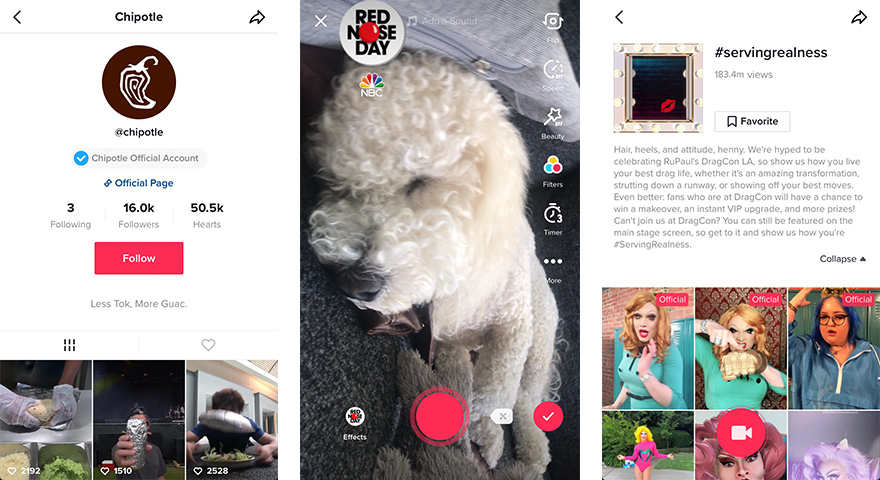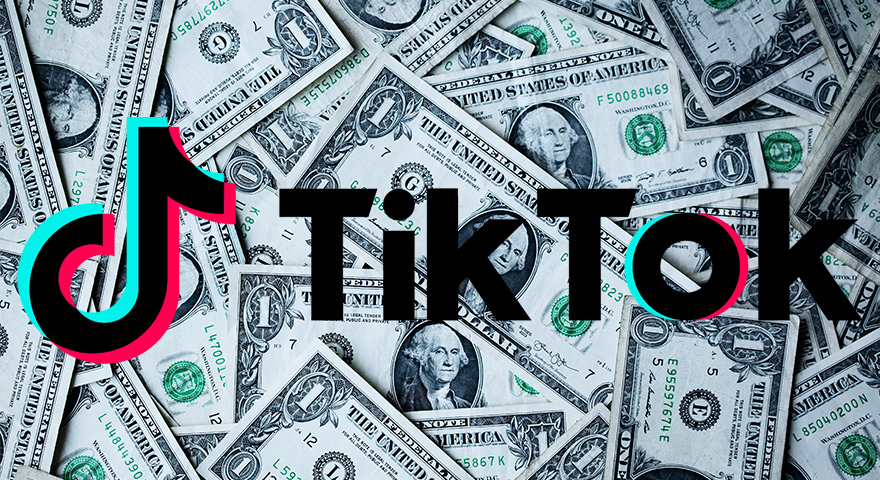The Brief: Take a deep dive into how money moves on TikTok, and how the app has the potential to be profitable while also providing a source of income for its top creators.
DEEP DIVE
What’s all the talk about TikTok? The short video social media app has taken the world by storm. Popular mostly among Gen Z-ers, TikTok is becoming increasingly relevant beyond just its user-base due to the prominence of its memes and internet trends, as well as the ways in which it is transforming social media content, profitability, virality, and more.
Last July, ByteDance reported that TikTok and Douyin (the Chinese version of the app) had over 500 million monthly average users, a number that has likely continued to rise, especially since in January, the company reported that Douyin had 500 monthly average users in China alone. ByteDance, which also owns the popular Chinese news aggregator Toutiao, has been valued at $75 billion dollars. ByteDance’s purported prospective moves into the markets of streaming, gaming, and gadgets indicate that the company is thinking beyond TikTok.
TikTok has the funds to back it up, but that doesn’t mean it’s profitable yet. The company has already faced fines of millions of dollars for privacy law violations. In order to live up to its exceedingly high expectations, ByteDance must find a way to monetize its popular system of meme creation and sharing. Massively successful memes such as the Yee Haw challenge demonstrate how TikTok combines meme culture, music sharing, and social media in unprecedented ways.
One of Vine’s most notable shortfalls was its inability to become profitable for its creators, and TikTok has the potential to succeed where Vine failed if ByteDance finds a way to keep users engaged while generating ad revenue that can support the platform and the creators it depends on for engaging content.
We’ve looked into what makes TikTok tick economically. As the app is relatively new, the ways in which revenue flows between advertisers, creators, users, partners, and ByteDance are constantly evolving. Money moves on TikTok, a free app, through brand takeover partnerships, sponsored hashtag challenges, ads between videos, influencer partnerships with TikTok and third parties, in-app purchases, music royalties, and brand-run accounts. In order to succeed financially and compete with social media giants like Facebook, TikTok’s must be profitable and attractive to advertisers and content creators, in addition to investors.
Music Royalties
TikTok can be a tool for artists to draw audiences to their music, but without royalties, they won’t be paid directly for their contribution to some of TikTok’s most viral memes. The massive popularity of Lil Nas X’s “Old Town Road,” which can be partially attributed to the TikTok #YeeHawChallenge shone a light on both TikTok’s potential as a music promotion platform and on how music artists can play a crucial role in the success of memes on the app.
As TikTok videos consist of 15-60 second clips, often set to music (to the point where it’s been called a lip-synching app), it must deal with music copyright and distribution of compensation for artists whose work is used. Copyright laws apply to clips used on TikTok, but creators are not always compensated, especially because it is difficult to track every instance of a song being used. While TikTokers have the option to link to a song that’s featured in their video, many songs remain unlabeled, thus not providing much exposure for the artists who created them.
Rumors about ByteDance’s future introduction of its own music streaming platform suggest that it would help resolve issues with music royalties and allow for more streamlined integration of content. If it were to involve a paid service like Spotify, Pandora, and Apple Music do, music streaming could provide a solid foundation for subscription-based revenue for ByteDance.
Sponsored Hashtag Challenges
Most major social media platforms rely on varying types of advertisements for revenue. On TikTok, ads often take the form of sponsored hashtag challenges. ByteDance has yet to release official information about how brand takeovers and sponsored hashtag challenge partnerships function, but evidence and reporting indicate that this is already and will continue to be a crucial element for TikTok’s ad revenue stream. Hashtag challenges thrive on TikTok, where the app’s interface and formulas specifically cater to this type of content sharing. On a typical day, when scrolling through TikTok’s search page, one will encounter at least one sponsored trend on a list of popular hashtags curated by TikTok. By creating hashtag trends that can turn into memes and go viral, brands can encourage TikTok creators to actively participate in trends that center their company or products.
According to an investigation by AdWeek, sponsored hashtag challenges have been sold to media buyers for a flat fee of $150,000 for six days with promotion and TikTok has advised buyers to budget an additional $100,000 to $200,000 to promote the challenge through other ad units.
Examples of this include the #BeABrawlStar challenge, which was sponsored by the makers of the app Brawl Stars (500+ million views), Taylor Swift’s #AnotherLikeMe challenge to promote her latest single (150+ million views), and the #FriendLikeMeChallenge to spread publicity about Disney’s Aladdin remake (248+ million views).
The Be A Brawl Star Challenge prompted TikTokers to use the duet feature to create videos of them dancing side-by-side with characters from the game to the song “All Star” by Smash Mouth. This campaign encouraged creators to make videos that combined their own dance moves with videos of Brawl Stars characters, thus integrating material from the game with a personal touch in every video.
While many of the videos featured through these hashtag campaigns show people completing a challenge, doing a dance, or otherwise fulfilling the hashtag’s prompt, some clever creators will tag an unrelated video with a popular sponsored hashtag to help bring in more views. Even in these cases, presumably, the publicity would still benefit the sponsor as it could still bring attention to their TikTok campaigns.
Brand Takeovers
Brand takeovers can consist of combinations of ads that show up when users open the app, banner ads, hashtag challenges, and sponsored lenses and filters for creators to use. Through a variety of advertising methods within the app, these brand takeovers can draw users back to a brand’s website or TikTok page and encourage them to participate in a sponsored hashtag challenge. AdWeek reported that prices for brand takeover ads can run between $50,000 and $100,000.

In-Feed, Banner, and Pop-Up Ads
In-feed ads can consist of videos or still images that appear among videos in a user’s “For You” or “Following” feeds. They then can link to a product’s website or to in Apple’s app store to immediately download an app. ByteDance has yet to disclose the pricing for such advertisements.
As anyone can make an account for free, companies have the opportunity to create a page for their brand to establish a presence on the app. From there, if they do purchase ads or hashtag challenge partnerships, they can tag their page in addition to linking to their site and product pages. TikTok’s user verification system (link to blue check mark) is currently in beta. A check mark can both clarify that a brand’s page is official and help draw traffic to it. Verified brand pages also have the option to link to an outside site, a feature that is not available to the average TikTok user.
In-App Purchases: Coins
Users have the option to purchase virtual coins through TikTok’s wallet feature that they can then give away to their favorite creators to show support. 100 coins can be purchased within the app for $0.99. Users spent a reported $5.5 million globally on coins in February 2019.
Coins can be exchanged for “gifts” and “diamonds” which can then be gifted to creators. The monetary value of these gifts are split between TikTokers and ByteDance. A BBC article reported that some children and teenagers have felt pressured to give gifts to creators and that some influencers promised to share their phone numbers or give other special treatment in exchange for monetary gifts.
Income For Creators
While TikTok appears to have multiple angles at which ByteDance can make money, the path towards profit for creators is less clear-cut. YouTube and Twitch partnership programs allow some popular creators to make lucrative earnings and many others to make enough to support their hobby. In order to be an attractive platform for top creators and influencers, TikTok will need to facilitate ways for them to monetize their videos in one way or another. At present, TikTok has not disclosed information about a partnership program or method of paying popular creators. Posts labeled with #TikTokpartner indicate that TikTok may have some sort of creator partnership program in the works.
TikTok’s top influencers and creators are often able to find sources of revenue through third-party sponsorships and partnerships. These can take the form of product placement and endorsements, paid videos for a brand’s page, shoutouts, and other advertisements. TikTok influencers can also use their presence on the app to direct attention to their other social media handles, Patreons, websites, and merch stores.
User Data Collection & Sales
Like many other free apps, TikTok may bring revenue now or in the future to ByteDance through the sale of user data and information collected from the app’s hundreds of millions of users. ByteDance already ran into some trouble with this when it was hit with a record fine for collecting data on minors. It has since changed its policies to make TikTok less accessible to children.
Where To Go From Here?
The viral success of TikTok means that the pressure is on for the service to stay relevant and remain profitable. TikTok’s economy functions in a variety of ways and money travels through a number of channels. As the app continues to evolve, it’s likely that these methods will become clearer and that there will be a smoother path for creators to earn money and for sponsors to take advantage of the app’s potential for monetizing memes and reaching a Gen Z audience.
